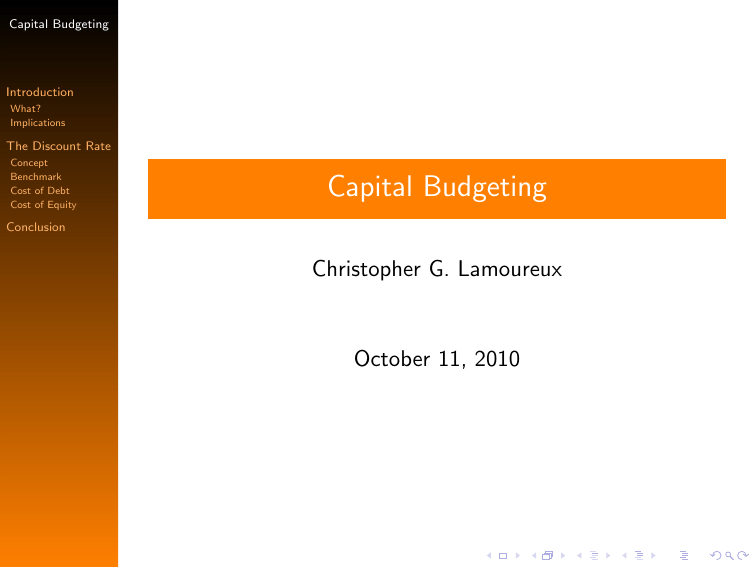Talk to Fin 512 on Capital Budgeting
advertisement

Capital Budgeting Introduction What? Implications The Discount Rate Concept Benchmark Cost of Debt Cost of Equity Capital Budgeting Conclusion Christopher G. Lamoureux October 11, 2010 Capital Budgeting Traditional Capital Budget Introduction What? Implications The Discount Rate Concept Benchmark Cost of Debt Cost of Equity Conclusion Each division manager is given a capital budget at the beginning of the year. By August, it was all spent. CFOs’ lament: What are we doing wrong? Root problem: Incentives. Since, spending the corporation’s capital: I Enhances division manager’s empire (political clout). I Allows shifting expenses from operating budget to capital. I Seems like an entitlement. (Each manager is jealous of other divisions’ allocations.) Capital Budgeting Puzzles Introduction What? Implications The Discount Rate Concept Benchmark Cost of Debt Cost of Equity Conclusion Capital should be unconstrained. If we have a positive NPV project that means (definitionally) that we should be able to finance the project in the marketplace. If that is not true, then we are using the wrong discount rates. In practice: Capital expenditures are highly politicized. Q: So, how can capital be constrained? A: You are not taking on positive NPV projects. (Furthermore, the only reason you need a capital budget is to artificially ration activity across the organization. It is an implicit recognition of the fact that the budget process elicits lies.) Capital Budgeting Solutions Introduction What? Implications The Discount Rate Concept Benchmark Cost of Debt Cost of Equity Conclusion Eliminate the whole notion of capital budget. Tie-in operational budgets with capital usage. An example of this thinking is Stern-Stewart’s Economic Value Added. Charge each manager for capital at current market costs. Evaluate managers by the (economic) ROA. The design of the budget process and the effect it has on incentives is much more important than the details of how projects are evaluated. Capital Budgeting The Idea Introduction What? Implications The Discount Rate Concept Benchmark Cost of Debt Cost of Equity The concepts are: I Money in future is less valuable than money today. I Discount rates must reflect relevant risks–as priced in the capital markets. I So this implies that you should know the financing mix. Conclusion Now the questions are: I What financing mix? I Which market costs? Capital Budgeting Easy Case Introduction What? Implications The Discount Rate Concept Benchmark Cost of Debt Cost of Equity For example, let’s consider a benchmark case: I The company is publicly traded, is a pure-play, and its capital structure is optimal. I The question of the specific source of funds is irrelevant (e.g., whether there is enough cash on hand, . . . ) Conclusion So using the (marginal) after-tax weighted average cost of capital is akin to a direct market test. Of course, in practice, the company exists because of some sort of market failure. As an example from Pioneer Petroleum, different divisions in the company have very different risk profiles. So the use of a single wacc across the divisions is inappropriate. Capital Budgeting Debt Introduction What? Implications The Discount Rate Concept Benchmark Cost of Debt Cost of Equity Conclusion At the optimal capital structure, what is the yield to maturity on newly issued 30-year debt? Statutory marginal tax rate will probably overstate the tax benefits of debt. In the event of losses, these carry-forward. In the event of bankruptcy these may be lost. Capital Budgeting Equity Introduction What? Implications The Discount Rate Concept Benchmark Cost of Debt Cost of Equity Conclusion Key concept in cost of equity is that only systematic risk is priced in the market. So the only risk to which you expose your (diversified) shareholders is that which they cannot diversify. Pioneer Petroleum notion of EBITDA yield (i.e., last year’s EBITDA divided by the stock price) is good for stable firms. Other approaches include CAPM and Fama-French factor model. (There are no tax benefits to equity.) Capital Budgeting Take Away Introduction What? Implications The Discount Rate Concept Benchmark Cost of Debt Cost of Equity Conclusion A public company has to have a value culture. It is the CFO’s job to create this culture and ensure that the common language driving all decisions is value optimization. As concerns capital budgeting this implies that there should not be a capital budget. Whoever is responsible for investing capital should be charged with earning a return on that investment that increases the value of the claims on the firm.







